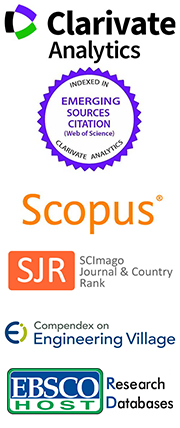Effects of Temperature and Torrefaction Time on the Physical Characteristics of Rice Straw Pellets with Dolomite
Abstract
Keywords
Full Text:
PDFReferences
Ostergaard P.A., Duic N., Noorllahi Y., and Kalogirou S., 2020. Latest progress in sustainable development using renewable energy technology. Renewable Energy 162: 1554-1562.
Intagun W. and A. Maden., 2020. Effect of mixing ratios on physical properties and energy consumption of Leucaena pellets by using fermented cassava-rhizome. Science, Engineering and Health Studies 14: 193-202.
Rajput S.P., Jadhav S.V., and Thorat B.N.., 2020. Methods to improve properties of fuel pellets obtained from different biomass sources: Effect of biomass blends and binders. Fuel Processing Technology 199:1-12.
Dhyani V. and T. Bhaskar., 2018. A comprehensive review on the pyrolysis of lignocellulosic biomass. Renewable Energy 129(Part B): 695-716.
Unchaisri T., Fukuda S., Phongphiphat A., Saetia S., and Sajjakulnukit B., 2019. Experimental study on combustion characteristics in a CFB during Co-firing of coal with biomass pellets in Thailand. International Energy Journal 19: 101-114.
Kongchouy P., Tia W., Nathakaranakule A., and Soponronnarit S., 2021. Assessment of seasonal availability and spatial distribution of bio-feedstock for power generation in Thailand. BioEenergy Research 1-21.
Kumar I., Feng K., Sun L., and Bandaru V., 2022. Adoption of biomass for electricity generation in Thailand: Implications for energy security, employment, environment, and land use change, Renewable Energy 195: 145-1467.
Carroll J.P., and J.M. Finnan. 2015. The use of additives and fuel blending of reduce emission from the combustion of agricultural fuels in small scale boilers. Biosystems Engineering 129:127-133.
Mlonka-Medrala A., Magdziarz A., Gajek M., Nowinska K., and Nowak W., 2019. Alkali metals association in biomass and their impact on ash melting behaviour. Fuel 261:1-17.
Toscano G., Feliciangli G., Rossini G., Fabrizi S., Pedretti E.F., and Duca D., 2019. Engineered solid biofuel from herbaceous biomass mixed with inorganic additive. Fuel 256:1-10.
Liu Y., Yan T., An Y., Zhang W., and Dong Y., 2021. Influence of water leaching on alkali-induced slagging properties of biomass straw. Journal of Fuel Chemistry and Technology 49:1839-1849.
Lachman J., Balas M., Lisy M., Milcak P., and Elbl P., 2021. An overview of slagging and fouling indicators and their applicability to biomass fuels. Fuel Processing Technology 217:1-10.
Zhu Z., Qingbo Y., Xie H., Wang K., Liu S., Yang F., Qin Q., and Qi Z., 2018. Mechanical and reduction characteristics of cold-pressed copper slag pellets composited within biomass and lignite. Renewable Energy 125: 206-224.
Kanoksilapatham W., Ogawa M., and Intagun W., 2020. Effects of clay and temperature on the slag formation of two biomass fuels: Wood from Acacia mangium and rhizome residual from Manihot esculenta. Renewable Energy 156: 213-219.
Chen C., Bi Y., Huang Y., and Huang H., 2021. Review on slagging evaluation methods of biomass fuel combustion. Journal of Analytical and Applied Pyrolysis 155: 105082.
Intagun W., Sonponpongpipat N., and Kanoksilapatham W., 2023. Fermented cassava-rhizome residue as a biomass pellet binding additive influenced by multi-bacterial biofilm. International Energy Journal 23(4): 219-228.
Chen W. and P. Kuo. Y., 2011. Torrefaction and co-torrefaction characterization of hemicellulose, cellulose and lignin as well as torrefaction of some basic constituents in biomass. Energy 36(2): 803-811.
Ribeiro J.M.C., Godina R., Matias J., and Nunes L.J.R., 2018. Future perspectives of biomass torrefaction: review of the current state-of-the-art and research development. Sustainability 10(7): 2323.
Sarker T.R., Azargohar R., Stobb J., Karunakaran C., Meda V., and Dalai A.K., 2022. Complementary effects of torrefaction and pelletization for the production of fuel pellets from agricultural residues: A comparative study. Industrial Crops and Products, 114740.
Bi D., Li B., Liu S., Yi W., Jiang M., and Lin Z., 2019. Influence of pyrolysis and torrefaction Pretreatment Temperature on the pyrolysis product distribution. BioResources 14: 1185-1197.
Zhang Y., Chen F., Chen D., Cen K., Zhang J., and Cao X., 2022. Upgrading of biomass pellets by torrefaction and its influence on the hydrophobicity, mechanical property, and fuel quality. Biomass Conversion and Biorefinery 12: 2061-2070.
Yang X., Zhao Z., Zhao, Y., Xu L., Feng S., Wang Z., Zhang L., and Shen B., 2023. Effects of torrefaction pretreatment on fuel quality and combustion characteristics of biomass: A review. Fuel 358(PartB): 130314
Ali A.M., Waheed A., Shahbaz M., Mirani A.A., Shahzad K., Zahrani A.A., Nawaz A.M., and Mahpudz A.B., 2023. Synergistic evaluation of co-torrefaction performance of rice husk and coffee bean ground blends for biosolid production for industrial fuel sustainability. Fuel 343: 127891.
Jezerska L., Sassmanova V., Prokes R., and Gelnar D., 2023. The pelletization and torrefaction of coffee grounds, garden chaff and rapeseed straw. Renewable Energy 210: 346-354.
DOI: https://doi.org/10.64289/iej.25.03A11.8937795


